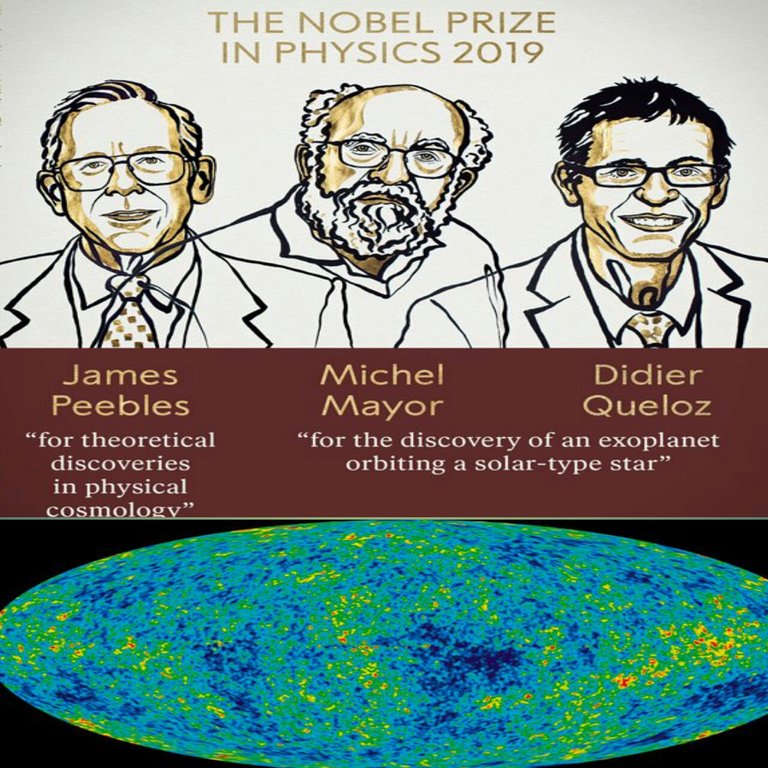
Stockholm: This year the Nobel Prize for Physics is being jointly awarded to three scientists in recognition of an investigation that has enabled us to better understand the evolution of the universe, and its place in the universe.
In this year's Nobel Prize for Physics, James Peebles is entitled to one-half, while the other half will be equally divided among Dr. Michael Meyer and Didier Kellows. This year, the Nobel Prize amount is 90 million Swiss Corona, which equates to about 14 million Pakistani rupees.

Canada-based James Peebles is one of the scientists of the 1970s who made significant strides in understanding the universe. Although previously Arno Panzias and Robert Wilson discovered "cosmic microwave backgrounds", Peabbles spoke of many things about the origin and evolution of the universe, where he also discovered Is the universe microscopic background really memorable when most of the material in the universe came in the form of atoms, resulting in a lot of energy being released and spread throughout the universe?
The cosmic microscopic background came into existence about three million years after the Big Bang, but with the continued cosmic expansion, the wave lengths have increased and today they have changed into microwaves… which we call the "Cosmic Microwave Background. ", Which is spread everywhere throughout the universe. It is with this background that we are able today to discover the finer details of the early universe.
Discovery of the First Solar Planets
Switzerland's Michael Mayer and Didier Kellows have been awarded the remaining half of the Nobel Prize for Physics this year. The two experts first discovered the planet revolving around another star in 1995. In this connection, they discovered the first planet "51 Pegasi B" which is circling us around a planet called "51 Pegasi" at a distance of 50 light years.
Before that, we were convinced that planets would rotate around other stars like our solar system, but by then we had not discovered any such planet.
For his first discovery, he based the motion of a star as a result of a gravitational attraction of a planet that rotates rapidly around it.
As the details of this discovery surfaced, a riot broke out all over the world. Since then, we have discovered more than 4,000 planets outside our solar system, including a few where the potential for life is particularly bright. So the discovery of Michael Meyer and Didier Kellows proved to be a milestone.
The current situation is that the number of extra-solar planets discovered in every 27 months doubles.
Nobel Prizes in Physics: Interesting Historical Facts
From 1901 to 2018, Nobel laureates have been awarded 112 times in the Physics / Physics field. During the First and Second World Wars there were six years in which no Nobel Prize was given: 1916, 1931, 1934, and from 1940 to 1942.
In these 118 years, a total of 210 people have been awarded the Nobel Prize for Physics, of which Jon Berardin was the only scientist to receive the Nobel Prize twice in this category.
Among the 210 Nobel laureates of physics, only Marie Curie, Maria Geopert Mayer and Donna Strickland were the three female scientists to receive the award.
Although June Berardine twice won the Nobel Prize in Physics, my Curie's unique honor is that he was awarded the 1903 Nobel Prize in Physics and the 1911 Nobel Prize for Chemistry.
Of these, 47 Nobel Prizes for Physics were awarded to one scientist (without participation); 32 awards were awarded to two specialists jointly; while three of the 33 Nobel Prizes in Physics were co-authored.
According to the Nobel Assembly, no single Nobel Prize can be divided into more than three persons.
According to the Nobel Assembly, no single Nobel Prize can be divided into more than three persons.
The average age of Nobel Laureates for Physics for 2018 is about 58 years.
The youngest scientist in the field of physics was William Lawrence Bragg, who received the award at the age of just 25. He along with his father, Sir William Henry Bragg, was equally involved in the 1915 Nobel Prize for Physics.
The oldest scientist in the same category was Raymond Davis Jr., who was awarded the Nobel Prize for Physics in 2002; he was 88 years old.
The Nobel Prize is given only to the living, meaning it cannot be nominated to anyone who has died.
The Nobel Foundation's constitution in 1974 decided that no one would be awarded the Nobel Prize after death; but if the relevant person died after the Nobel Prize was announced. That Nobel Prize will remain in his name. Prior to 1974 only 2 people were awarded the post-death Nobel Prize, but no one has been awarded the Nobel Prize since then.
The Cory family is also known as the "Noble Family" because it was first co-owned by Mary Cory and her husband, Perry Cory, in 1903 (jointly with Henry Beckler); Juliet Curie, along with her husband Frederick Juliet, were entitled to the 1935 Nobel Prize for Chemistry. Thus one family won a total of 5 Nobel Prizes because my Curie was also awarded the Nobel Prize for Chemistry in 1911.
Nobel laureates for father and son physics: William Bragg and Lawrence Bragg were awarded the Nobel Prize together in 1915; Nils Bohr won the Nobel Prize in Physics in 1922, and his son Aggie Niles Bohr won in 1975; Mann Saigban. In 1924, his son, Kym Saigban, won the 1981 Nobel Prize in Physics; while the renowned Sir Joseph June Thomson (JJ Thomson) won the Nobel Prize in Physics in 1906 and his son George Paget Thomson in 1937. Also won the Nobel Prize for this field.